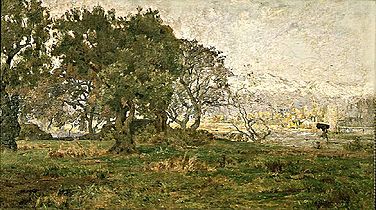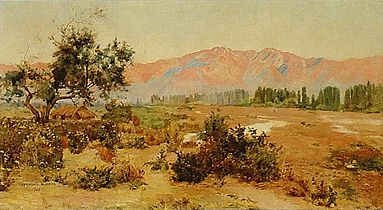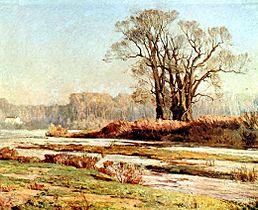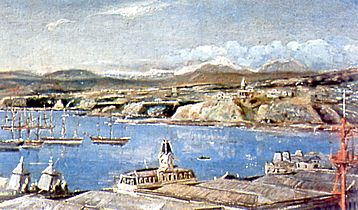Alberto Valenzuela Llanos facts for kids
Quick facts for kids
Alberto Valenzuela Llanos
|
|
|---|---|
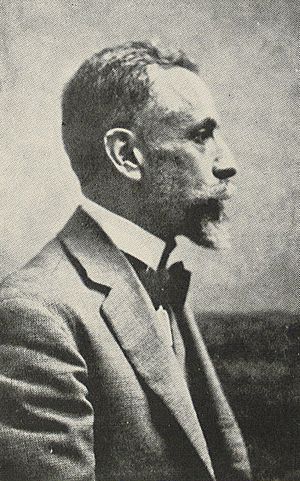
Alberto Valenzuela Llanos
|
|
| Born |
Ramon Alberto Valenzuela Llanos
August 29, 1869 |
| Died | July 23, 1925 (aged 55) |
| Nationality | Chilean |
| Known for | Painting |
| Movement | Grandes Maestros de la pintura Chilena (Great Masters of the Chilean Painting). |
Alberto Valenzuela Llanos (born August 29, 1869, in San Fernando, Chile – died July 23, 1925, in Santiago, Chile) was one of Chile's most important painters. He is known as one of the four Great Chilean Masters, alongside Pedro Lira, Alfredo Valenzuela Puelma, and Juan Francisco González.
Alberto Valenzuela Llanos was especially good at painting landscapes. He created about 1,000 paintings during his life. Some of his most famous works show the snowy mountains in France and beautiful views of Paris.
He learned from Chilean artists Cosme San Martín and Juan Mochi. Both of them were directors of the Chilean National Museum of Fine Arts in Santiago. Juan Mochi had the biggest influence on Alberto's painting style. He also learned from the Chilean romantic painter Onofre Jarpa.
Contents
Life of a Painter
Alberto Valenzuela Llanos was born in San Fernando, a city in the Colchagua area of Chile. His family used to be very rich but had lost most of their money. His parents, Florencia Valenzuela Llanos and Ricardo Lira, were cousins from a family with a long history of owning land and serving in the military.
As a young boy, Alberto loved nature. He enjoyed walking around the countryside and sketching trees and colors. People knew him as a polite and respectable young gentleman.
He went to public school and then to a high school that focused on science and humanities. As his family's money problems got worse, young Alberto decided to work in a local fabric store. He didn't like the job, but he knew he had to help his family.
One quiet day, when he was 17, he started drawing lilies on a piece of fabric out of boredom. The store owner saw the ruined fabric. Even though he was annoyed, he was also impressed and showed the drawings to Alberto's father.
His father was amazed by Alberto's talent. He decided that his son was meant to be an artist. He convinced his brother to let Alberto live with him in Santiago, Chile's capital city. This way, Alberto could study at both the Instituto Nacional General José Miguel Carrera and the Academy of Painting (Santiago, Chile).
Luckily for Alberto, the new director of the Academy was Juan Mochi. Unlike earlier directors, Mochi encouraged his students to find their own unique style. He didn't mind if they used new or different art techniques. This freedom allowed Valenzuela to spend his life painting what he loved most: landscapes.
He painted simple, textured landscapes using soft pinks and greens. His paintings of springtime truly capture the morning light. His canvases were often very large, much bigger than what was common at the time.
Because his family had faced money problems, Alberto learned to paint many pictures quickly. This meant his art became widely known across Chile. He enjoyed painting everyday scenes from the capital city. He started with places like Lo Contador (now a street in Providencia), the mountains of the Cajón del Maipo south of Santiago, and the coast of Algarrobo.
Alberto was a calm and peaceful person. His favorite hobby was painting with oils. He stayed away from the lively, sometimes wild, art scene of his time and didn't get involved in political fights. He always cared about his parents, siblings, and friends back home. He would often take the train to Colchagua to visit them.
His painting skills quickly improved thanks to Juan Mochi's guidance. He started focusing on oil painting and used more sketches before starting a final piece. Most importantly, he developed his own unique style, which came from his hard work and his family's needs.
This personal style brought him early recognition. In 1889, his work was shown at the "Salon official de Santiago," a famous art exhibition. The next year, he won a bronze medal at the annual salon contest. More awards and recognition followed quickly. In 1890, one of his paintings was shown at the Salon de peinture et de sculpture in Paris, France. This was a big achievement for an artist from Latin America.
Then, in 1891, he won an award at an exhibition in the United States. The Chilean government offered him a scholarship to study in Paris, France, in exchange for teaching art for a few years when he returned.
Alberto accepted the scholarship right away and went to France. He studied with Jean-Paul Laurens at the Académie Julian. Laurens had also taught other Chilean painters. In Paris, Alberto learned about impressionism and expressionism. This was a very productive time for him, and he created many paintings of Paris at dawn. In 1913, his hard work paid off when he won an award at the Salon de peinture et de sculpture again.
With support from the Chilean government, he traveled regularly throughout Europe between 1901 and 1906. He visited Spain, Italy, and England, as well as France, where he continued to study and paint.
Finally, in 1906, he returned home to Chile. He was hired to teach drawing at the Liceo Miguel Luis Amunátegui high school in Santiago. In 1910, he married Julia Montero, one of his young students. After that, he took over from Fernando Alvarez de Sotomayor y Zaragoza as a painting professor at the School of Fine Arts, where he taught for several years.
He taught his students in the same way he had been taught, encouraging them to find their own artistic style. His students loved him. He often pushed them to explore Santiago and visit its most famous places to find inspiration.
Alberto Valenzuela Llanos passed away in Santiago on July 23, 1925. Today, most of his paintings are owned by private collectors. However, some of his most famous works can be seen in public places. These include the Chilean National Museum of Fine Arts, the Central Bank of Chile, the Casa del Arte in Concepción, and the O'Higgins Fine Arts Museum in Talca.
Amazing Achievements and Awards
- 1894 Edwards award price, Exposición Nacional Artística (National Art Exhibition), Santiago, Chile.
- 1895 General Marcos Maturana Price, Exposición Nacional Artística, Santiago, Chile.
- 1895 Medalla de Primera Clase en Paisaje, National Art Exhibition, Santiago, Chile.
- 1896 General Maturana award, National Art Exhibition, Santiago, Chile.
- 1897 Edwards award price, National Art Exhibition, Santiago, Chile.
- 1900 Edwards award price, Salón Oficial (the official hall), Santiago, Chile.
- 1901 Honourable mention, Buffalo exhibition, Estados Unidos.
- 1903 Medal of Honor, Salón Oficial (the official hall), Santiago, Chile.
- 1904 General Marcos Maturana award, Salón Oficial (the official hall), Santiago, Chile.
- 1910 Gold Medal, Santiago International Exhibition, Museo Nacional de Bellas Artes, Santiago, Chile.
- 1910 Silver Medal, Buenos Aires exhibit, Argentina.
- 1912 General Maturana Price, Salón Oficial (the official hall), Santiago, Chile.
- 1912 Medal of the Society of French Artists, París hall, Francia.
- 1913 Second place medal, Salon (Paris), Francia.
- 1914 Silver Medal, Edwards award, Salón Oficial (the official hall), Santiago, Chile.
- 1920 Public Instruction Officer, given by the French government in recognition to his merit.
- 1923 Chevalier (Knight) cross Legion of Honour given by the French government in recognition to his merit.
- 1924 It was awarded a place as member of the Society French Artist.
See His Art! (Selected Works)
Images for kids
-
O'Higgins Fine Arts Museum, Talca, Chile
See also
 In Spanish: Alberto Valenzuela Llanos para niños
In Spanish: Alberto Valenzuela Llanos para niños
- Chilean art
- Pablo Burchard
- Juan Francisco González
- Pedro Lira Rencoret
- Alfredo Valenzuela Puelma


